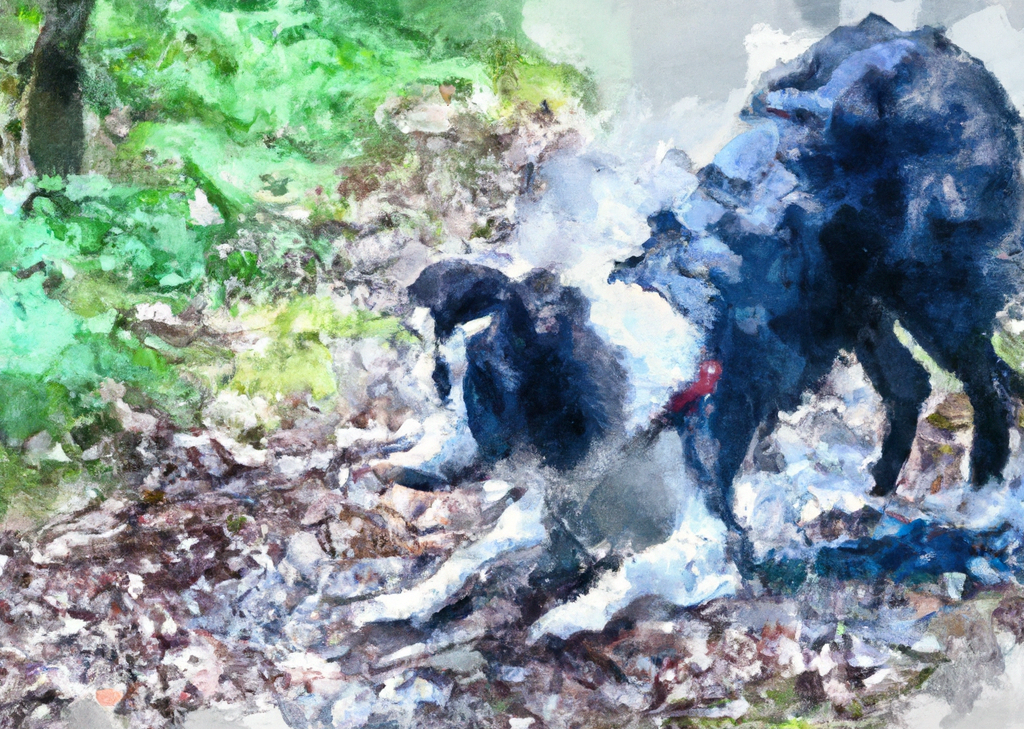Canine Arthritis – Diagnosis, Treatment, and Prevention
What is it?
How is it Treated?
Breed Predispositions
Large breeds such as Labrador Retrievers, Golden Retrievers, German Shepherds, and Rottweilers Giant breeds such as Great Danes, Saint Bernards, and Newfoundlands
Introduction
For years, Tom and his trusty Labrador, Max, had been inseparable, sharing countless adventures in the great outdoors. They’d hiked steep mountains, explored lush forests, and splashed in refreshing streams. But lately, Max had been slowing down. The once-vigorous dog now hesitated to climb the stairs and struggled to rise from his bed. Heartbroken, Tom knew something was amiss, so he took Max to their local veterinarian. After a thorough examination, the vet confirmed that Max was suffering from arthritis, a painful joint condition that affects many dogs.
Arthritis is a prevalent condition in dogs, often called ‘dog arthritis.’ It primarily involves inflammation and degeneration of the joints, often resulting from the wearing out of joint tissues. This deterioration typically leads to discomfort and reduced mobility. In addition, factors such as aging, genetics, injuries, and obesity can elevate a dog’s risk of developing arthritis, especially in breeds like the Labrador Retriever, German Shepherd, and Golden Retriever.
The disease process initiates when the cartilage, a component that typically serves as a buffer within the joint, starts to deteriorate. This breakdown causes the bones to rub against each other, leading to pain, swelling, and loss of joint movement. Moreover, the constant bone-on-bone contact over time can culminate in the development of bony growths, further constraining an arthritic pet’s mobility.
If you think your dog may be suffering from arthritis, it can potentially affect any joint; it is frequently observed in areas such as the hips, elbows, lower back, knees, and wrists. Although more prevalent in older dogs, arthritis can also impact younger dogs, especially those with predisposing factors. Such factors include prior injuries or genetic susceptibilities like hip or elbow dysplasia.
Types of Arthritis in Dogs
Arthritis in dogs is generally categorized into different types based on the causes and affected areas. Most dogs will develop some form of arthritis by age eight, but 20 percent of them start showing signs at an earlier age. The following are some common types of arthritis found in dogs:
Osteoarthritis (Degenerative Joint Disease)
Osteoarthritis, also known as Degenerative Joint Disease, is the most common type of arthritis in dogs. It’s a progressive condition characterized by the gradual degeneration and wearing away of the cartilage that cushions the joints. As the cartilage wears away, bones rub against each other during movement, leading to discomfort, pain, and reduced mobility. Osteoarthritis can affect any joint, but it is most commonly found in the hips, elbows, knees, wrists, and spine. While it’s often associated with aging, other factors like obesity, genetics, and joint injuries can also contribute to developing dog osteoarthritis.
Rheumatoid Arthritis
Rheumatoid arthritis in dogs is an autoimmune disease, which means the dog’s immune system mistakenly attacks its body tissues. In this case, it primarily targets the synovial membrane lining the joints, causing inflammation and resulting in pain, swelling, and stiffness. Over time, this condition can lead to erosion of the bone and cartilage within the joints, leading to decreased mobility. Unlike osteoarthritis, which is more common in older dogs, rheumatoid arthritis can affect dogs of all ages and is typically more severe, though it’s less common overall. The exact cause of this autoimmune response is unknown.
Septic Arthritis
Septic arthritis in dogs is a type of arthritis that is caused by a bacterial or, less commonly, fungal infection within a joint. The infection can be introduced to the joint through a wound or a surgical procedure, or it can spread from an infection in another part of the dog’s body. Once the joint becomes infected, it leads to inflammation, swelling, and pain and can cause severe damage to the joint if left untreated. This condition differs from other forms of arthritis because it is caused by an infection rather than a chronic degenerative process or an immune-mediated attack on the joints. However, it requires immediate veterinary care, as the infection can spread and become life-threatening.
Immune-Mediated Polyarthritis
In dogs, immune-Mediated Polyarthritis (IMPA) is an inflammatory disease affecting multiple joints. Unlike osteoarthritis, a degenerative condition, IMPA is caused by the dog’s immune system attacking the lining of the joints, leading to significant inflammation and discomfort. It’s often characterized by sudden onset of lameness, fever, lethargy, and loss of appetite. IMPA can be idiopathic, meaning it has no identifiable cause or can be secondary to underlying conditions such as infection, cancer, or certain drugs. The precise cause of the immune system’s inappropriate response is poorly understood, but it’s generally thought to be a complex interaction of genetic and environmental factors. Therefore, prompt diagnosis and treatment are crucial to alleviate pain and preserve joint function.
Hip Dysplasia
Hip Dysplasia in dogs is a common skeletal condition, especially in large or giant breed dogs. A malformation of the hip joint characterizes it – instead of a smooth ball and socket, the joint becomes loose and irregular. This results in the surfaces of the bones rubbing and grinding instead of sliding smoothly. Over time, this can lead to discomfort, pain, and decreased function and mobility. The condition is primarily hereditary, but rapid growth, diet, and physical activity can also influence its development and progression. While Hip Dysplasia is a chronic and progressive condition, various management strategies, including weight control, exercise moderation, and specific medical or surgical treatments, can significantly improve the quality of life for affected dogs.
Each type of arthritis can cause pain and discomfort in your dog and may require different treatment strategies.
What Causes Canine Arthritis?
Arthritis in dogs arises from various factors, and certain breeds are known to experience specific types of arthritis more frequently than others. For instance, a hereditary issue such as hip dysplasia often results in arthritis in some dogs. Moreover, conditions like cruciate ligament rupture, elbow luxation, and spinal stenosis can trigger arthritis in an arthritic dog.
- Age: Natural wear and tear on a dog’s joint due to aging can lead to arthritis. Breed: Some breeds, especially larger ones, are more prone to arthritis due to their substantial size and weight.
- Obesity: An overweight dog is exposed to higher stress on its joints, escalating the risk of arthritis.
- Joint Infections or Diseases: Conditions like Lyme disease can provoke joint inflammation and damage, ultimately leading to arthritis.
- Injury or Trauma: Any joint injuries, such as a broken bone or ligament tear, can gradually lead to arthritis.

- Genetic Factors: Certain dogs may have an inherent genetic tendency towards developing arthritis.
- Poor Nutrition: A diet deficient in the necessary nutrients for joint health can contribute to the development of arthritis. If a pet owner is still determining a healthy diet, it’s best to ask your veterinarian.
- Lack of Exercise: Both excessive and insufficient exercise can lead to joint stiffness and eventually result in arthritis. Regular, moderate exercise assists in maintaining joint flexibility and health. However, it’s also essential to maintain muscle mass for additional support to the joints.
- Degenerative Arthritis: This is a progressive condition where the joint cartilage deteriorates over time, leading to inflammation and pain.
Symptoms of Arthritis in Dogs
- Struggling with sitting or standing, often due to painful joints.
- Hesitation or stiffness when rising from a resting position, indicating potential osteoarthritis pain.
- Showing signs of limping or favoring a certain limb, a common symptom of dog arthritis.
- An apparent decrease in activity levels or a reluctance to engage in playtime or walks.
- Displaying discomfort when touched or petted, particularly around the common areas.
- Presence of swelling or warmth in the joints, which may be a sign of inflammation.
- Experiencing weight gain or displaying a decreased appetite.
- Undergoing changes in behavior, such as increased aggression or other mood changes.
- Finding difficulty in tackling stairs or jumping up to or down from certain heights.
- A noticeable muscle tone or mass decrease often results from decreased activity due to joint pain.
Diagnosis of Arthritis in Dogs
Diagnosing arthritis in dogs involves a comprehensive process aimed at ruling out other conditions and determining the severity of the disease. Here are the steps a vet typically takes:
Physical Examination
A comprehensive physical examination is an initial step for any disease diagnosis, including arthritis. Your vet will carefully examine your dog’s joints, checking for swelling, tenderness, restricted movement, and other signs of joint damage. They’ll also examine the dog’s overall body condition and movement to assess any lameness, stiffness, or other signs of discomfort.
History and Symptoms
Your vet will ask about your dog’s history and the symptoms you’ve observed at home. Information about when the symptoms first appeared, their severity and impact on your dog’s life can be very helpful in making a diagnosis.
Radiographs (X-Rays)
Radiographs provide a clear picture of your dog’s skeletal structure, allowing the vet to identify any joint changes indicative of arthritis, such as bone spurs, joint space narrowing, or other abnormalities.
Joint Fluid Analysis
In some cases, your vet may recommend a joint fluid analysis. This involves taking a sample of the fluid from the dog’s affected joint and analyzing it for signs of inflammation or infection.
Blood Tests
Blood tests can help rule out other conditions that might be causing your dog’s symptoms. They can also provide important information about your dog’s health and ability to tolerate potential treatments.
Advanced Imaging
When the condition of the joints and surrounding tissues needs to be assessed in greater detail, more advanced imaging techniques such as MRI or CT scan may be deemed necessary by veterinary surgeons.
These diagnostic instruments provide unique insights, aiding your vet in determining if your dog has degenerative arthritis, evaluating its severity, and planning the most suitable treatment.
Should your pet exhibit signs of severe arthritis, it’s crucial to ensure they receive adequate treatment. A wide array of treatments are available for dogs’ arthritis, with anti-inflammatory drugs often prescribed by veterinarians to alleviate your dog’s pain. To slow the progression of osteoarthritis, vets might also prescribe natural remedies or joint supplements such as glucosamine and chondroitin sulfate, which aid joint lubrication and cartilage health.
Additional medications can curb the disease’s progression and relieve discomfort, while surgery may be required to mend damaged joints or replace diseased ones.
Holistic veterinarians suggest an inclusive approach to treating arthritis in dogs, which involves tackling the root cause rather than merely focusing on symptoms. For instance, if your dog suffers from joint issues due to insufficient exercise, consider involving him in a weight training program. Additionally, you can provide him with supplements promoting healthy joints.
Animal Physical Rehabilitation

Owners of pets suffering from osteoarthritis (OA) often discover that their pets can greatly benefit from certified small animal physical rehabilitation. Rehabilitation encompasses a multifaceted approach to aiding an animal’s recovery from OA, including physical therapy, medication, and dietary modifications, guided by a skilled small animal physical rehabilitation practitioner. In addition, there’s the ongoing development of specific exercises for pets with OA, but commonly recommended activities include weight-bearing exercises like walking and running; aquatic exercises such as swimming; manipulative therapies such as massage; and pain relief medications.
Laser Treatment
Laser therapy is a concentrated form of energy that can address various conditions. It’s particularly effective in treating pain and inflammation and averting or postponing joint degeneration. In some instances, laser therapy may also enhance a dog’s ability to walk.
Photodynamic therapy (PDT) is a standard laser treatment for arthritis. It employs a specific laser to inflict damage on cells in the target area, resulting in local inflammation and pain relief.
Acupuncture
Acupuncture is believed to assist dogs with osteoarthritis by triggering the body’s natural healing mechanisms. It can mitigate inflammation, enhance circulation, and alleviate the pain associated with arthritis. It may be used with other treatments to maximize the benefits for your dog. While acupuncture cannot cure arthritic joints, it can considerably ease pain and enhance your pet’s overall mobility.
Through inserting thin acupuncture needles into various acupuncture points, acupuncture can:
- Release endorphins, which are the body’s natural pain-relief hormones.
- Ease tight and achy muscles surrounding your pet’s joints.
- Enhance blood flow and promote circulation.
- Reduce your pet’s reliance on or the dosage of chronic medications.
- Help reduce inflammation. Adequan Injections
Adequan Injections
Adequan, a polysulfated glycosaminoglycan (PSGAG) injection, treats osteoarthritis in dogs. It’s believed to function by lubricating and cushioning the joint and inhibiting the enzymes that degrade the joint cartilage and joint capsule. Adequan is typically administered as an intramuscular injection, with the recommended dosage and frequency varying based on the size and condition of the dog. Treatment typically comprises a series of injections given over several weeks. While Adequan is generally considered safe for dogs, it shouldn’t be used in animals with known bleeding disorders or those receiving anticoagulant therapy. As always, consult a veterinarian before commencing treatment with Adequan.
Supplements for Treating Arthritis in Dogs
Many different supplements can be given to dogs with arthritis to help them feel better and improve their overall quality of life. Some of the most commonly recommended accessories for treating arthritis in dogs include:
- Omega-3 fatty acids – One study has shown that giving omega-3 fatty acids to dogs with arthritis reduced their symptoms by as much as 67%. Therefore, ensuring your dog gets enough omega-3s through his diet or supplementation is an excellent way to help him feel better overall.
- Glucosamine – Glucosamine is a natural compound that has been shown to help relieve the symptoms of arthritis. Some studies have found it more effective than traditional medications in treating this condition. Therefore, giving your dog glucosamine supplements may be one of the best ways to help him feel better quickly.
- Chondroitin sulfate – Chondroitin sulfate is another natural compound that has been shown to help relieve the symptoms of arthritis. Like glucosamine, studies have also found it more effective than traditional medications in treating this condition. Therefore, providing your dog with chondroitin supplements may be one of the best ways to help him feel better quickly.
- Curcuminoid extract – Curcuminoids are compounds found in turmeric and other plants that have been shown to improve inflammation and pain associated with arthritis.
Environmental Support Around Your Home
Environmental support can help dogs with arthritis. It is vital to modify the home to make it easier for your dog to move around. For example:
- Install ramps or steps – Put in ramps or pet steps to help your dog reach its favorite resting spots, like on the couch or bed.
- Raise food and water bowls – Use a small shelf or sturdy box to raise them so your dog can reach them more easily without bending down.
- Orthopedic beds for dogs – Orthopedic beds relieve pressure on the joints and muscles by distributing weight evenly for good support. Even dogs who don’t need orthopedic mattresses for a disorder can benefit from the supportive comfort of an orthopedic bed. In addition, providing a supportive place to rest can help your best friend feel better and potentially help prevent degeneration and injuries.
- Add carpeting for better traction – Consider putting in carpeting or secure rugs to help your dog gain traction and stay steady on its feet.
- Assist your dog – Help your dog manage by carrying your pup up the stairs or lifting them into the car whenever possible.
Prevention for Arthritis in Dogs
There are many different types of arthritis, and each requires a slightly different treatment plan. However, there are several things you can do to help manage symptoms. These include:
- Exercise – Regular walks and play sessions will help maintain muscle strength, mobility, and fitness. Limit sedentary activities such as watching TV and playing computer games if possible.
- Diet – A well-balanced diet rich in protein and omega fatty acids will support joint health. Avoiding foods high in sugar and starch will reduce inflammation.
- Lifestyle – Limit stress by keeping your dog active and busy. Try to keep his environment clean and free of toxins.
- Vaccinations – Make sure your dog gets all required vaccinations.
- Supplements – Consider using glucosamine and chondroitin supplements to help build up cartilage and strengthen joints.
Dog Breeds That Can Benefit From Joint Supplements as Puppies
In breeds that have the potential for joint disease, it is recommended to start joint supplements. These breeds are most commonly at risk for common issues:
- Hip and knee: Any toy to giant breed dog can be affected, but these are the most common:
- Toy breeds: Miniature Poodles, Boston Terriers, Chihuahuas, Pugs (knee), and Yorkshire Terriers
- Medium to large breeds: American Staffordshire Terrier, Labrador Retrievers, Golden Retrievers, Boxers, American Bulldogs, English Bulldogs, German Shepherds, Mastiffs
- Giant breeds: Great Danes, St. Bernards
- Elbow (tends to be breed-specific): English Bulldogs, Welsh Corgis, Dachshunds, Golden Retrievers, Labrador Retrievers
- Shoulder (tends to be breed-specific): Labradors and Golden Retrievers
Frequently Asked Questions
Disclaimer: The information provided on this veterinary website is intended for general educational purposes only and should not be considered as a substitute for professional veterinary advice, diagnosis, or treatment. Always consult a licensed veterinarian for any concerns or questions regarding the health and well-being of your pet. This website does not claim to cover every possible situation or provide exhaustive knowledge on the subjects presented. The owners and contributors of this website are not responsible for any harm or loss that may result from the use or misuse of the information provided herein.







